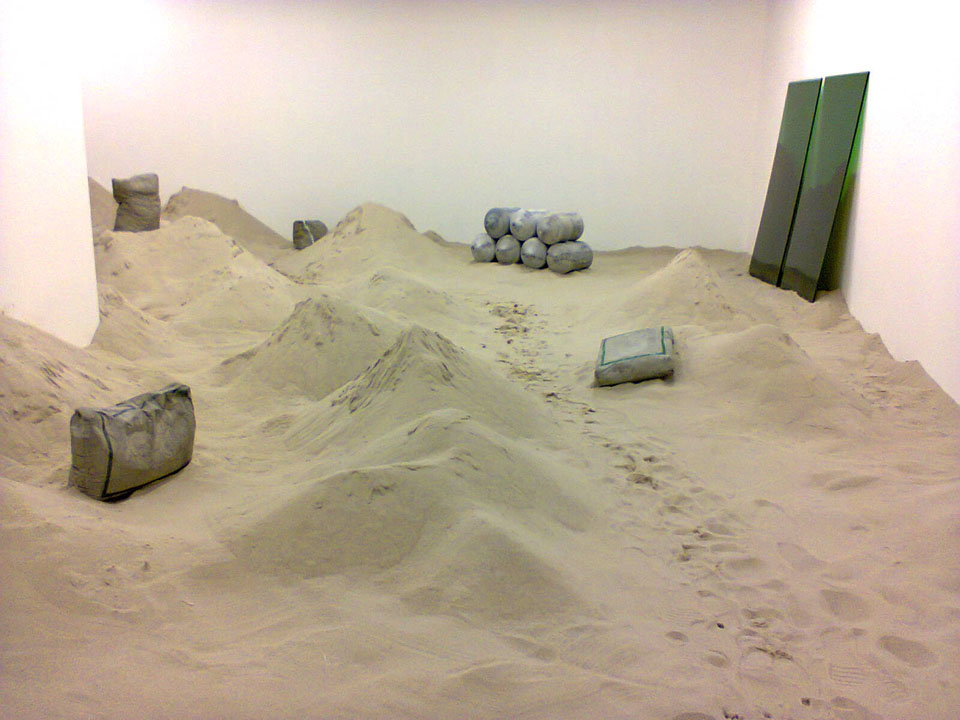Hong Kong, September 23 – October 22, 2016, http://edouardmalingue.com/
At first sight, the exhibition consisted of a couple of cubic meters of beach sand dumped into the gallery and decorated with concrete casts of concrete sacks and water dispenser water bottles. A stereotypical relaxed sliding guitar “beach” music further supported the feel of an abandoned beach, littered with oversized relics of civilization. A second look revealed a number of details and discrepancies that made it harder to reconcile the notion of a straightforward beach-in-the-city understanding of the installation.
To grasp the overall experience, the location has to be described first. E. Malingue is a gallery located on the 6th floor of a modern office building in Central. The interior of the building is designed from a number of materials emanating a grey coolness: grey concrete, grayish marble, stainless steel and glass. One enters through the lobby and after a short elevator ride is spit out right into the exhibition space. A strong visual element of the space is the floor consisting of tiles with a metal frame and synthetic grey color filling, designating it as an office space prior to the laying of a carpet. Probably this is the same base across the building and probably it is covered it with a carpet in most offices. Here, exposed, it underlines the continuity of the space with the surrounding environment. White cardboard walls were erected inside of the space and it was illuminated from above with suspended neon lights. The height of the ceiling was office space-like too, not too low but not too tall either.
The sand spread around the gallery by Paiva covered a large part of the floor and separated the gallery space into three areas: the entrance, the “beach” and a showcase on the other side of the “beach” hidden behind a corner. Covering the floor with sand was something that was unexpected, making the space look special. The sand was not evenly spread, but it has been shaped into a series of mounds, which did not look very beach-like. They more reminded of a construction site or construction waste dump. The casts of concrete sacks also supported the feel of an abandoned construction site, where a couple of cement sacks hardened under rough weather conditions. This impression clashed with the beach bar music playing in the background. Water dispenser bottles have been also cast from grey concrete, like the sacks. But their presence on the beach/construction site was a mystery, as they are usually not present on either of these locations. Beaches are usually full of small size plastic trash, like PET bottles or fragments of doll corpses, as could be seen TRES’ exhibition a few months ago, and not large numbers of these large containers. Water dispenser bottles most of all connote office spaces, such as those surrounding the location of the exhibition itself. Probably a water dispenser could be found even somewhere inside of the gallery. Thus to the beach/construction site, the connotation of office was added.
The impressions were oscillating between beach/construction site/office, when in fact it was a gallery space. The gallery aspect was of course present in the white cardboard walls, which through the use of construction materials within the show became almost part of the exhibit, as did the remainders of the visible flooring and hanging lights. The gallery feel was also enhanced by the care given to the arrangement of objects: The sand was not simply sand on the floor, but it was shaped and a specific walking path for visitors designed. Concrete casts have been arranged into “poses”, like the sack placed on the top of a mound, making it look almost like a tombstone. Large Styrofoam board casts were even mounted onto the cardboard walls.
The clue to the exhibition has been a small booklet with technical drawings sourced from a Hong Kong government department responsible for construction and public space engineering. It was placed on a small moving trolley close to the door and could easily be missed. It pointed towards the idea of construction and building, the process through which a green island turns into a concrete island. When one transfers the gallery situation back to an actual beach, construction site or office, one realizes that none of these “environments” are as independent from each other as they appear at first. They are all related and overlap to some extent: The beach represented in the office through the sand used as a building material. The construction site, which is a temporary bridge between the green island’s beach the concrete island’s office blocks. And the office, which contains both of them within the process of its creation as well as its finished state: The sand contained in the walls, floors and ceilings and the distilled purified water gently shivering from the vibrations of the cooling unit of the water dispenser in the kitchenette, distantly reminding of miniature sea waves.





